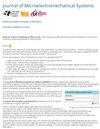用于双轴微镜的MEMS气阻尼隔振器:宽频率隔振
IF 3.1
3区 工程技术
Q2 ENGINEERING, ELECTRICAL & ELECTRONIC
引用次数: 0
摘要
双轴微镜在AEC-Q100鉴定试验中的断裂失效不能仅仅通过结构设计来减轻,因为需要在弯曲和扭转刚度上的相容性。为了解决这个问题,提出了一种被动MEMS隔振器,以保护微镜在20 Hz至1200 Hz的宽频率范围内,而不像传统设计局限于固定频率。与现有方法采用的单自由度微镜隔离系统相比,该方法基于二自由度微镜隔离系统。隔离器的刚度与微镜的刚度相匹配,以最大限度地提高镜面运动,并采用空气阻尼机构,利用20~ μ m的间隙控制动态响应时间。设计的隔振器采用新型玻璃上soi工艺制作,并在配有激光多普勒振动仪的高精度激振器上进行了测试。结果表明,该隔振器减振幅度为25.55 dB,与设计值24.89 dB基本一致。此外,一项汽车级振动测试表明,在20 Hz至1200 Hz频率范围内的50g振动下,微镜成功隔离,没有引入可能破坏微镜工作模式的寄生模式。[20240220]本文章由计算机程序翻译,如有差异,请以英文原文为准。
MEMS Air-Damped Isolator for Dual-Axis Micromirrors: Broad-Range Frequency Vibration Isolation
The fracture failure of dual-axis micromirrors under the AEC-Q100 qualification test could not be mitigated by structural designs alone due to the need for compatibility in bending and torsional stiffness. To address this, a passive MEMS vibration isolator was proposed to protect the micromirrors within a broad frequency range of 20 Hz to 1200 Hz, unlike conventional designs limited to a fixed frequency. The proposed method was based on a two-degree-of-freedom (DOF) micromirror-isolator system, in contrast to the single-DOF systems employed in existing methods. The isolator’s stiffness was matched to the micromirror’s stiffness to maximize the mirror plane’s movement, and an air damping mechanism was incorporated using a $20~\mu $ m gap to control the dynamic response time. The designed isolator was fabricated using a novel SOI-on-glass process and tested on a high-precision vibration shaker equipped with a laser Doppler vibrometer. Results showed that the proposed isolator attenuated vibration amplitude by 25.55 dB, closely aligning with the design value of 24.89 dB. Additionally, an automotive-grade vibration test demonstrated successful isolation under a 50g vibration within the 20 Hz to 1200 Hz frequency range, without introducing parasitic modes that could disrupt the micromirror’s operational modes.[2024-0220]
求助全文
通过发布文献求助,成功后即可免费获取论文全文。
去求助
来源期刊

Journal of Microelectromechanical Systems
工程技术-工程:电子与电气
CiteScore
6.20
自引率
7.40%
发文量
115
审稿时长
7.5 months
期刊介绍:
The topics of interest include, but are not limited to: devices ranging in size from microns to millimeters, IC-compatible fabrication techniques, other fabrication techniques, measurement of micro phenomena, theoretical results, new materials and designs, micro actuators, micro robots, micro batteries, bearings, wear, reliability, electrical interconnections, micro telemanipulation, and standards appropriate to MEMS. Application examples and application oriented devices in fluidics, optics, bio-medical engineering, etc., are also of central interest.
 求助内容:
求助内容: 应助结果提醒方式:
应助结果提醒方式:


